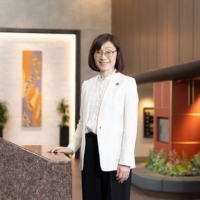At the Dairakudakan performance space in Kichijoji, a group of female performers move with the particular deliberateness of the butoh dance style. Their partners in the dance are snow-white noh masks, fully true to tradition but with one important modification: lurid red tongues extend and curl from their mouths. The dancers bite the masks' tongues, holding them a few centimeters from their own faces in silent, mirrored confrontation.
Akaji Maro, who founded Dairakudakan (Great Camel Battleship) in 1972 and remains its prime inspiration, watches over the rehearsal, a large notebook open before him. His taut frame leans out toward the performers in poised attentiveness. He calls out instructions, but his key directions take the form of gargled yowls: "Give it more urrrhg!''
Maro's involvement with the spectral world of butoh dates back to the 1950s and his studies under Tatsumi Hijikata, the founder of the style. Over the decades, Dairakudakan has been guided by a number of Maro's concepts, including tempu-tenshiki ("being born into the world is a great talent in itself") and ichinin-ippa ("one dancer, one school"), which stresses the importance of individuals developing unique movement vocabularies.

















With your current subscription plan you can comment on stories. However, before writing your first comment, please create a display name in the Profile section of your subscriber account page.